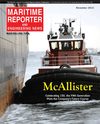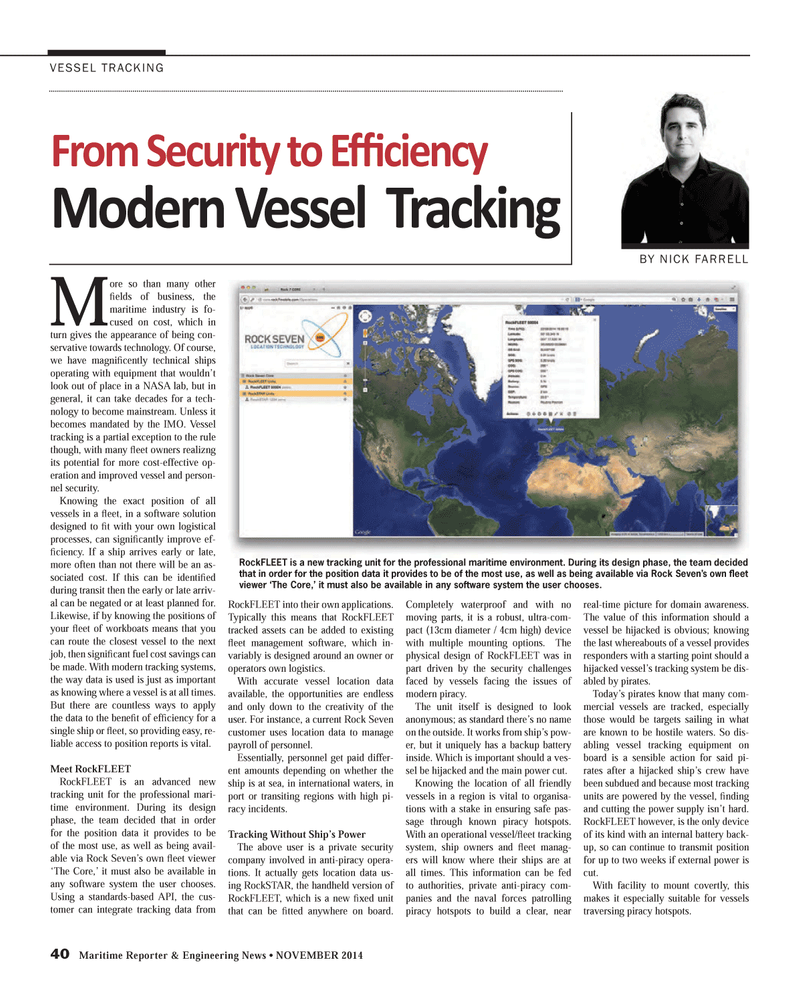
Page 40: of Maritime Reporter Magazine (November 2014)
Workboat Edition
Read this page in Pdf, Flash or Html5 edition of November 2014 Maritime Reporter Magazine
40 Maritime Reporter & Engineering News • NOVEMBER 2014
VESSEL TRACKING
M ore so than many other ? elds of business, the maritime industry is fo- cused on cost, which in turn gives the appearance of being con- servative towards technology. Of course, we have magni? cently technical ships operating with equipment that wouldn’t look out of place in a NASA lab, but in general, it can take decades for a tech- nology to become mainstream. Unless it becomes mandated by the IMO. Vessel tracking is a partial exception to the rule though, with many ? eet owners realizng its potential for more cost-effective op- eration and improved vessel and person- nel security.
Knowing the exact position of all vessels in a ? eet, in a software solution designed to ? t with your own logistical processes, can signi? cantly improve ef- ? ciency. If a ship arrives early or late, more often than not there will be an as- sociated cost. If this can be identi? ed during transit then the early or late arriv- al can be negated or at least planned for.
Likewise, if by knowing the positions of your ? eet of workboats means that you can route the closest vessel to the next job, then signi? cant fuel cost savings can be made. With modern tracking systems, the way data is used is just as important as knowing where a vessel is at all times.
But there are countless ways to apply the data to the bene? t of ef? ciency for a single ship or ? eet, so providing easy, re- liable access to position reports is vital.
Meet RockFLEET
RockFLEET is an advanced new tracking unit for the professional mari- time environment. During its design phase, the team decided that in order for the position data it provides to be of the most use, as well as being avail- able via Rock Seven’s own ? eet viewer ‘The Core,’ it must also be available in any software system the user chooses.
Using a standards-based API, the cus- tomer can integrate tracking data from
RockFLEET into their own applications.
Typically this means that RockFLEET tracked assets can be added to existing ? eet management software, which in- variably is designed around an owner or operators own logistics.
With accurate vessel location data available, the opportunities are endless and only down to the creativity of the user. For instance, a current Rock Seven customer uses location data to manage payroll of personnel.
Essentially, personnel get paid differ- ent amounts depending on whether the ship is at sea, in international waters, in port or transiting regions with high pi- racy incidents.
Tracking Without Ship’s Power
The above user is a private security company involved in anti-piracy opera- tions. It actually gets location data us- ing RockSTAR, the handheld version of
RockFLEET, which is a new ? xed unit that can be ? tted anywhere on board.
Completely waterproof and with no moving parts, it is a robust, ultra-com- pact (13cm diameter / 4cm high) device with multiple mounting options. The physical design of RockFLEET was in part driven by the security challenges faced by vessels facing the issues of modern piracy.
The unit itself is designed to look anonymous; as standard there’s no name on the outside. It works from ship’s pow- er, but it uniquely has a backup battery inside. Which is important should a ves- sel be hijacked and the main power cut.
Knowing the location of all friendly vessels in a region is vital to organisa- tions with a stake in ensuring safe pas- sage through known piracy hotspots.
With an operational vessel/? eet tracking system, ship owners and ? eet manag- ers will know where their ships are at all times. This information can be fed to authorities, private anti-piracy com- panies and the naval forces patrolling piracy hotspots to build a clear, near real-time picture for domain awareness.
The value of this information should a vessel be hijacked is obvious; knowing the last whereabouts of a vessel provides responders with a starting point should a hijacked vessel’s tracking system be dis- abled by pirates.
Today’s pirates know that many com- mercial vessels are tracked, especially those would be targets sailing in what are known to be hostile waters. So dis- abling vessel tracking equipment on board is a sensible action for said pi- rates after a hijacked ship’s crew have been subdued and because most tracking units are powered by the vessel, ? nding and cutting the power supply isn’t hard.
RockFLEET however, is the only device of its kind with an internal battery back- up, so can continue to transmit position for up to two weeks if external power is cut.
With facility to mount covertly, this makes it especially suitable for vessels traversing piracy hotspots.
From Security to E? ciency
Modern Vessel Tracking
BY NICK FARRELL
RockFLEET is a new tracking unit for the professional maritime environment. During its design phase, the team decided that in order for the position data it provides to be of the most use, as well as being available via Rock Seven’s own fl eet viewer ‘The Core,’ it must also be available in any software system the user chooses.
MR #11 (34-41).indd 40 10/28/2014 10:34:14 AM

 39
39

 41
41
